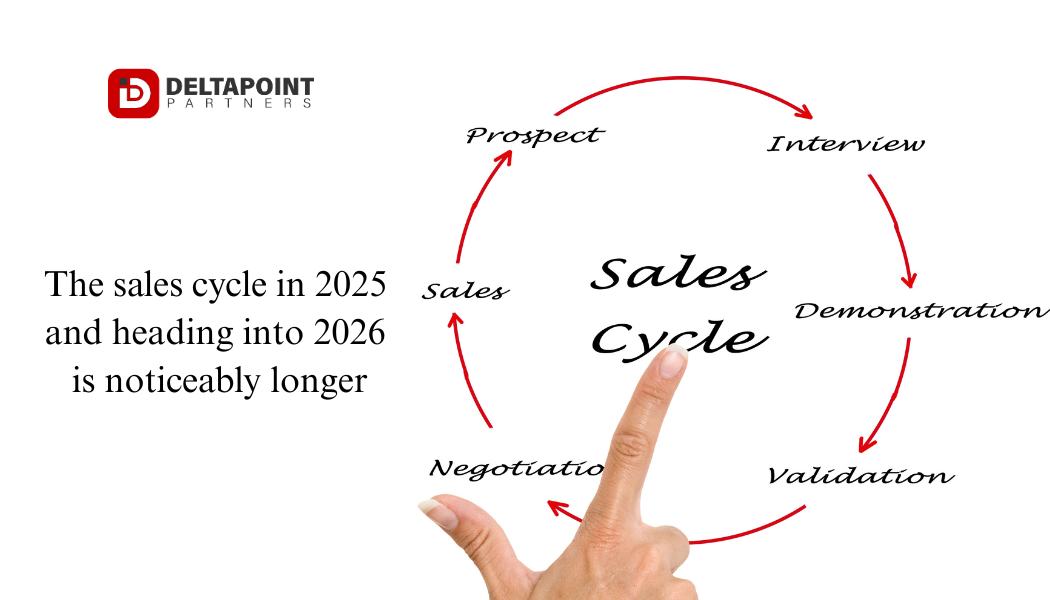The sales cycle in 2025 and heading into 2026 is noticeably longer, and it’s not your imagination. Nearly every industry (B2B services, manufacturing, cybersecurity, staffing, consulting, medical products, etc.) is reporting longer times from first contact to closed business.
Below is why the modern sales cycle is stretching and what’s driving it today.
Why the Sales Cycle in 2025–2026 Is Longer Than Ever
- More Decision-Makers Than Ever Before
In 2010, the average buying committee had 3 people.
Today, it is 7–13 people, depending on the industry.
More people = more opinions = more objections = more delays.
Even small companies now involve:
- Finance
- Operations
- Legal
- IT/Security
- End-users
- Executive sponsors
Every step adds friction and time.
- Risk Aversion Is Way Up
Organizations are extremely cautious due to:
- Inflation impact
- Uncertain economy
- Budget freezes/slow releases
- Increased scrutiny on ROI
- Fear of making a “bad purchase”
Buyers are moving slower because they don’t want to be wrong.
- Budget Approval Is More Complicated
Budget approvals now require:
- Multi-layered justification
- ROI projections
- Compliance/security validation
- Vendor onboarding processes
- In some cases, board review
Even when a decision-maker says “We want this,” the internal process drags.
- Buyers Are Overwhelmed with Options
Every industry is oversaturated.
Buyers are:
- Comparing more vendors
- Requesting multiple demos
- Seeking internal alignment
- Delaying because they “need more information”
The overload effect slows purchasing.
- Attention Is More Fragmented Than Ever
Decision-makers are juggling:
- More emails
- More meetings
- More priorities
- More fires to put out
Good solutions get stuck because buyers don’t have the mental bandwidth to move forward.
- Procurement and Legal Bottlenecks
Vendor reviews now include:
- Legal
- Compliance
- Risk/security vetting
- Supplier diversity documentation
- Insurance requirements
- Background checks (for staffing/security firms)
Even small deals can be delayed by corporate bureaucracy.
- Buyers Self-Educate for Longer
Instead of talking to sales on day 1, buyers now:
- Research silently
- Read reviews
- Download content
- Follow your company online
- Compare alternatives
By the time they do reach out… they’re still not ready to buy.
- Short-Staffed Departments Delay Decisions
Every department is stretched thin.
This creates delays like:
- Finance not reviewing the proposal
- IT not finishing security checks
- Leadership meetings getting pushed
- Operations not evaluating feasibility
Deals die because of bandwidth—not interest.
- Fear of Change & Change Management Issues
Even when the solution is better, companies worry about:
- Disruption
- Training
- Implementation
- Internal adoption
- Existing vendor relationships
“Doing nothing” feels safer.
- Prospect Follow-Up Is Weak in Most Industries
This is the #1 reason YOUR business can win.
Most sales teams:
- Stop too early
- Don’t nurture consistently
- Don’t stay visible
- Don’t follow up long-term
- Don’t track engagement
- Don’t build relationships
If the buying cycle is 6–12 months or longer and you only follow up for 30–60 days, you lose.
What This Means for Sales in 2025–2026
✔ Buyers need more touches than ever
12–20+ meaningful touches is now the norm.
✔ Visibility is the new pipeline
If you disappear, they forget you.
✔ Consistency wins
Because most of your competitors won’t stay in touch long enough.
✔ Content + email + phone + LinkedIn = the new “must”
One channel alone won’t move a modern buyer.

